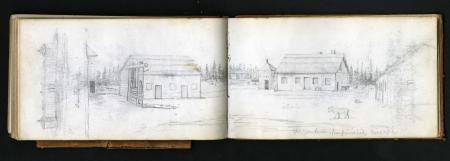
When people think of a Smithsonian exhibit, they probably don’t think of one filled with documents from an archives! A piece of paper doesn’t grab your attention from across the room, as the Fénykövi elephant or Chuck Berry’s car do. But on closer inspection, handwritten scraps have fascinating stories to tell. They can be difficult to display for long periods of time, since light can fade the ink and trigger deterioration in the paper. They are not as sturdy as a rocket or a sculpture. However, they can be displayed for about three months in controlled environmental conditions. Scanning technology also can produce amazing facsimiles and keep the originals secure in climate-controlled storage.
The Archives has long loaned collections for exhibits, such as a pen and ink drawing of a Wilkes Expedition fish by Alfred T. Agate for a 1982 exhibit, The Capital Image: Painters in Washington, D.C., 1800-1915, at the Smithsonian American Art Museum. So in 1984, while located in the Arts and Industries Building, the Archives launched its own exhibit program in the Archives foyer. With a used case from the Office of Exhibits, the Archives put up an exhibit on the Theodore Roosevelt African Expedition of 1910-1912. The Archives holds an extensive collection documenting Roosevelt’s post-presidential safari to collect animals for the National Museum of Natural History, which was then under construction. The exhibit was well-received, so the program continued.
On the 100th anniversary of the birth of Smithsonian Secretary Alexander Wetmore in 1986, we celebrated with an exhibit. A “shutterbug,” Wetmore’s thousands of photographs of travels across the globe told the story of a life devoted to studying our avian cousins. The exhibit opening included a luncheon, screening of home movies made by his assistant, Watson M. Perrygo, and was attended by 150 Wetmore fans. In 1991, an exhibit opened on Secretary Charles Doolittle Walcott and his discovery of Burgess Shale fossils in the Canadian Rockies in the 1910s. The exhibit space now had three cases with wall displays. It used photographic facsimiles of images and documents so it was durable, including Walcott’s magnificent panoramas which he studied to find the best field sites. When it was taken down the exhibit was moved to the Natural History Museum’s Department of Paleobiology. A 1993 biography of Smithsonian Secretary Baird, Spencer Baird of the Smithsonian, was celebrated with a new exhibit highlighting some of the achievements mentioned in the book.

A 1995 exhibit focused on the issue of repatriation, rather than the achievements of a famous individual. With as Much Specificity as Possible demonstrated the important role that archives play in documenting the provenance of museum objects so they can be repatriated to the correct descendants. 1996 saw the opening of Nineteenth-Century African-American Employees of the Smithsonian, telling stories of talented and devoted individuals who have contributed to the Institution since its earliest years. Later exhibits looked at postcards of the Smithsonian, including ones with messages that detailed the visitor’s experiences, and at “Snowflake Bentley,” a pioneer in snowflake photography.

Related Resources
Produced by the Smithsonian Institution Archives. For copyright questions, please see the Terms of Use.

Leave a Comment